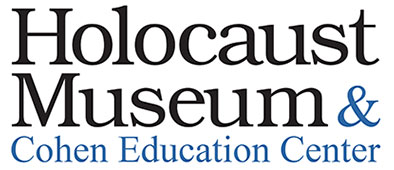Audio Tour
Thank you for taking our audio tour. To follow the tour in the Museum, go to the location in the accompanying pictures.
Stop 1 - Pre-War Jewish Life
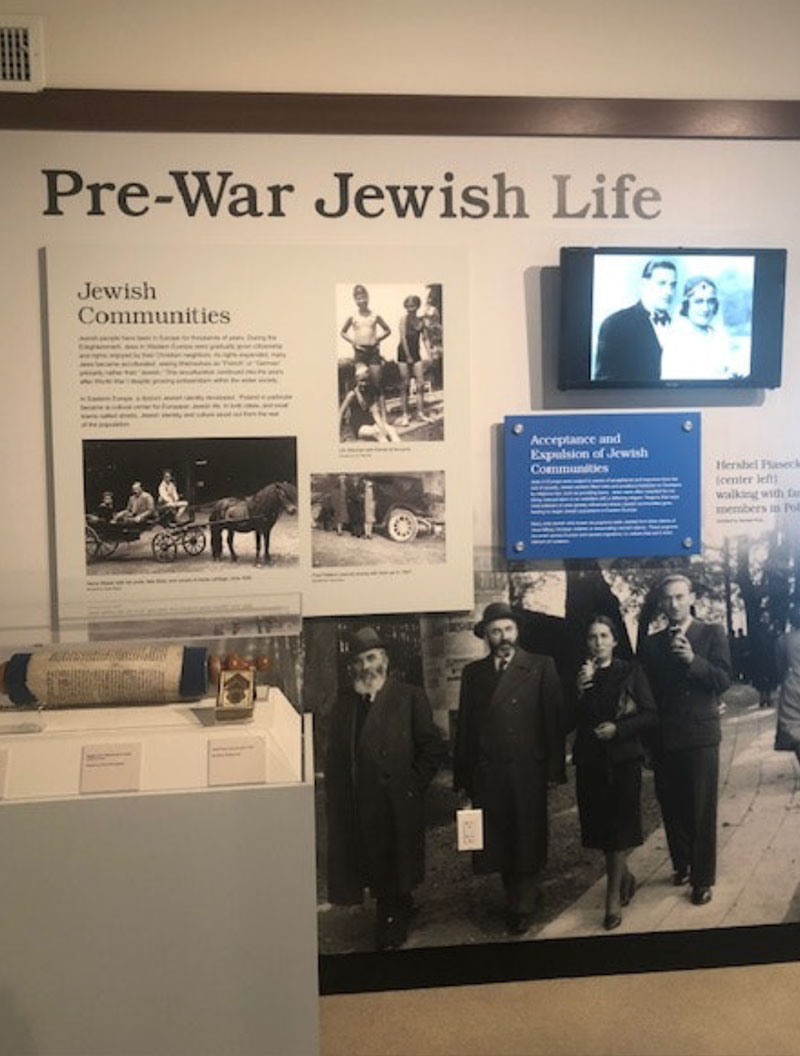
The Holocaust was a state-sponsored persecution and annihilation of European Jews and other so-called undesirables by Nazi Germany and its collaborators between 1933 and 1945. Although Jews were the main target of the Nazi Regime, others were also persecuted, including Communists, homosexuals, Roma and Sinti Gypsies, Serbs, Poles, Jehovah’s Witnesses and the mentally and physically handicapped. In the early 20th century, Germany was considered the epitome of culture in Europe, yet it became one that was willing to kill its own people and others throughout the war.
Antisemitism is the opposition to and hatred of Jews, a common component of European history. Jews, as a minority, were often blamed for problems within a community, ultimately leading to widespread events of persecution and violence. However, despite persistent stereotypical perceptions and hatred towards them, Jews became valued members of many communities. The Enlightenment granted Jews in Western Europe individual rights and citizenship, with Jews beginning to view themselves as ‘Europeans’ first rather than ‘Jewish’.
These changes meant little for German Jews during the 1900’s, as the defeat in World War I, establishment of the Versailles Treaty, and the Great Depression were all blamed on the Jewish community, making them the primary scapegoat for any problems facing the nation.
Stop 2 - The Rise of the Nazi Party
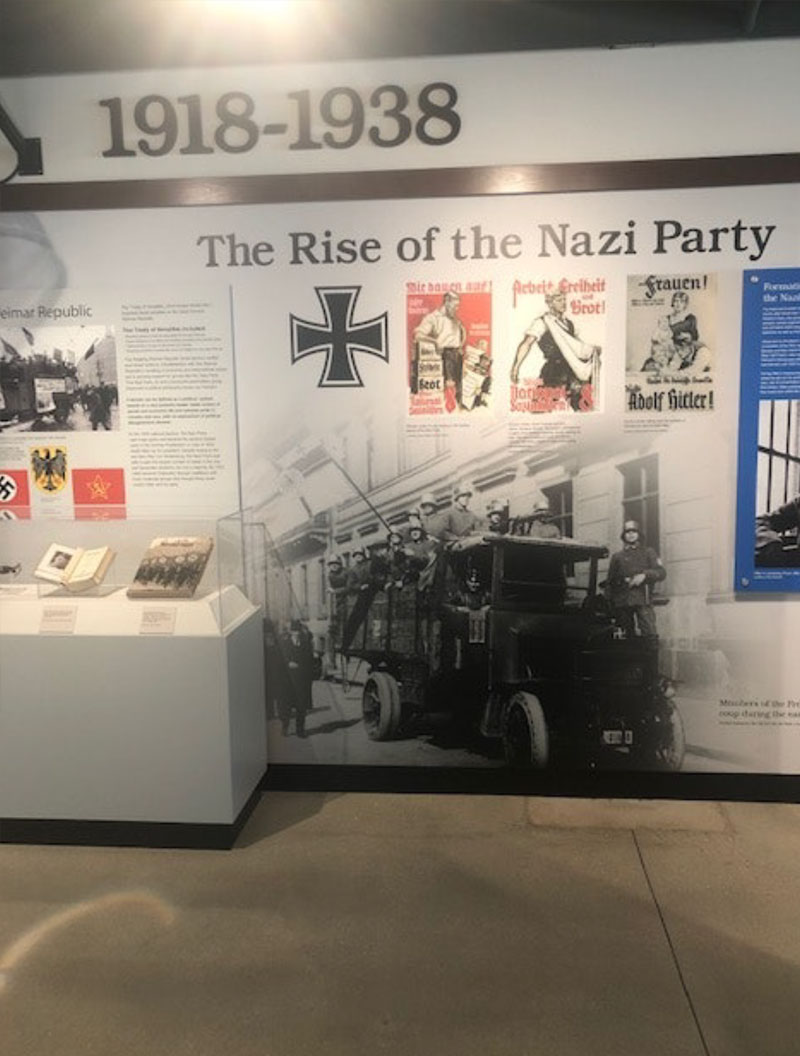
The Treaty of Versailles created an untested democratic framework for Germany, known as the Weimar Republic, which quickly became unstable during the Depression. In Germany, over 30 political parties vied for power, all with ideas of how to rescue the nation from its current situation and restore its glory. One of the many displaced soldiers from World War I looking to rebuild his life during this political turmoil was Adolf Hitler. Employed by the German Army as a confidential informant, he spied on these political parties and reported back to his superiors. Hitler believed that Germany was undermined by its Jewish population, and blamed the subsequent loss of WWI, the armistice, and other issues on them. After attending a meeting of the German Workers’ Party in September 1919, Hitler joined what would become the National Socialist German Workers’ Party and began his climb to power.
In the November 1932 elections, the Nazi Party won 33% of the votes and 196 seats in the Reichstag, enabling them to have Hitler appointed as Chancellor of Germany which he became in January 1933. That placed Hitler second only to President Paul von Hindenburg. Soon after, the Nazis intensified their propaganda campaign to gain public support and conscript more people into their political ideology. At the same time, actions such as the boycott of Jewish businesses and book confiscation and burning occurred, marginalizing Jewish culture while promoting pure German heritage.
Stop 3 - The Third Reich 1933-38
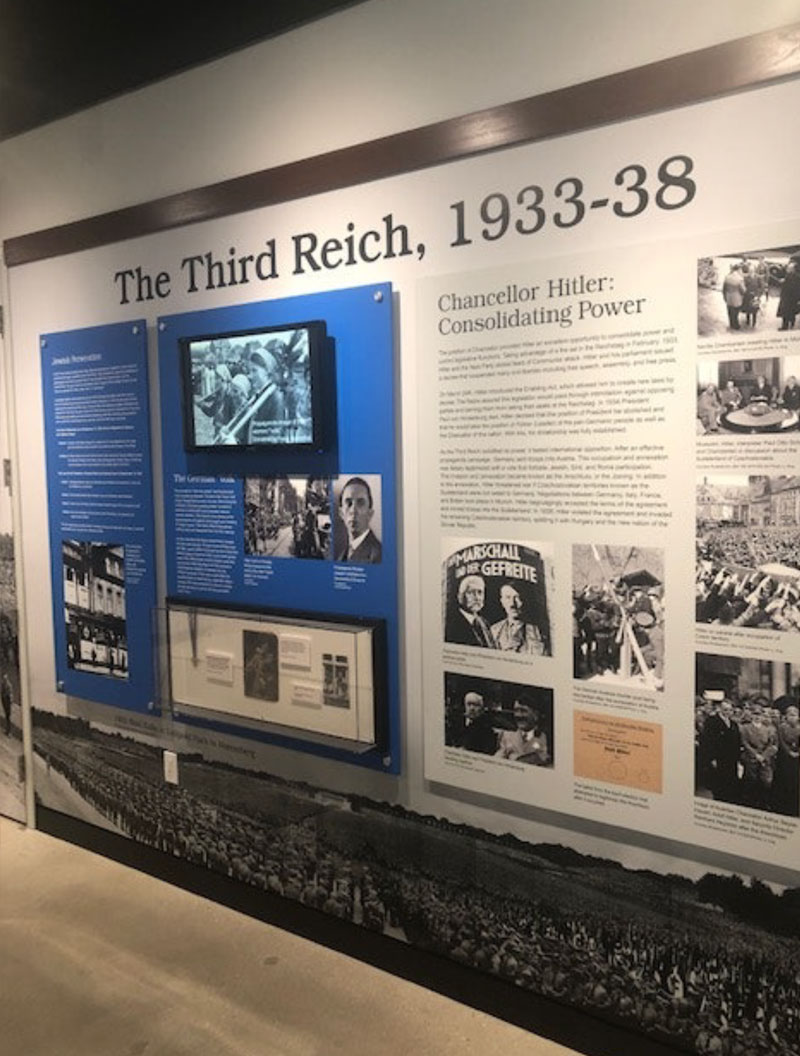
On March 24th, 1933, Hitler continued to expand his power by introducing the Enabling Act, granting him the power to create new laws by decree. Following the death of President von Hindenburg in August 1934, Hitler claimed absolute power by declaring himself der Führer, leader and dictator of Nazi Germany. For the next 5 years Hitler would gain totalitarian control over Germany by utilizing the SS, SA, Hitler Youth, and Aryan propaganda. All these components heavily relied on the ‘Aryan Volk’ concept, which reinforced ideas of German supremacy and formed an identity. This idea also encouraged Germans to preserve their dominant blood through Eugenics, ensuring their blood line would not be tainted by non-Germans.
In March 1938, with armed forces he was not supposed to have per the terms of the Treaty of Versailles, Hitler invaded Austria, his homeland, in what was called the Anschluss, German for the peaceful “union”. Within days, the Austrian government aligned with Germany and began implementing similar laws against Jews and other enemies of the Reich, German for “empire”. Hitler continued his territorial gains in September when he demanded that Czechoslovakia give up the Sudetenland, an area that bordered Germany, because the residents spoke German and were of German descent. Against the wishes of Czechoslovakia, the Western European governments negotiated the Munich Agreement under the leadership of Neville Chamberlain, Prime Minster of Britain, and gave the land to Hitler. Chamberlain believed this would quell Hitler’s desire to claim more territory and prevent any conflict with Germany from breaking out, declaring shortly after the agreement that he had secured “peace for our time.”
Stop 4 - Jewish Persecution
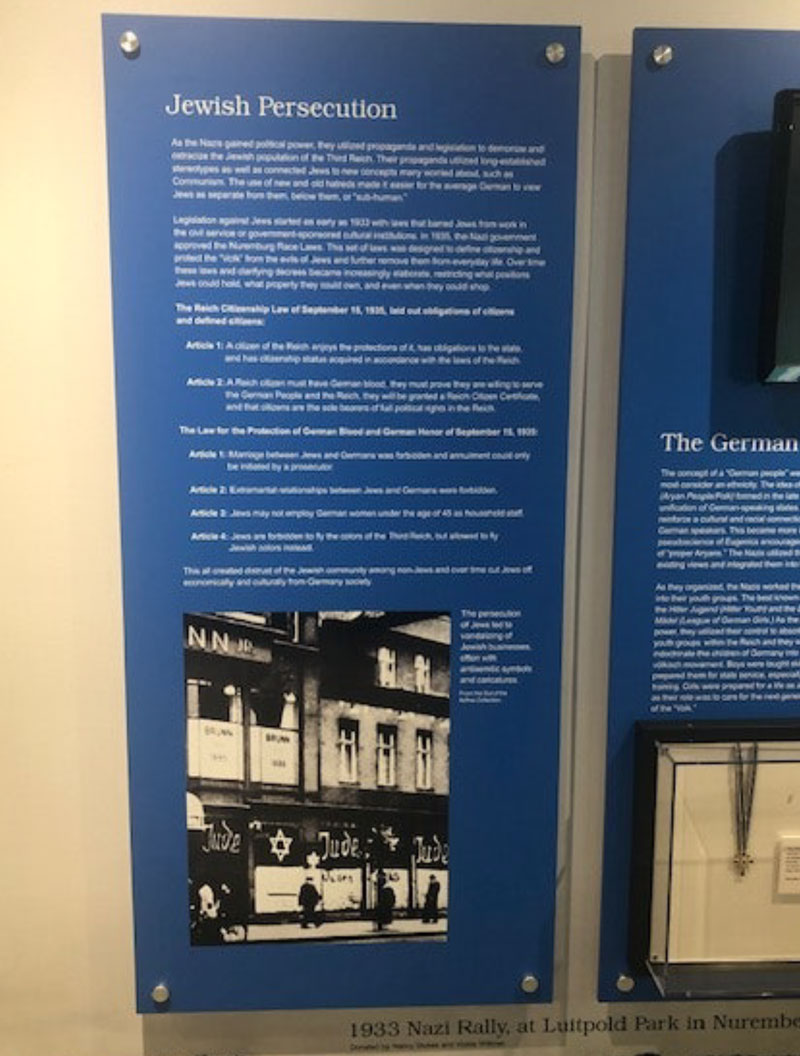
In September 1935, the Nazis announced the Nuremburg Race Laws and codified discrimination against non-Aryans living in Germany. Systematic targeting of individuals had been utilized previously, such as in 1933 when the first concentration camp, Dachau, was built outside of Munich. It housed political prisoners that threatened Nazi dominance including Communists, Social Democrats, religious leaders and others who spoke against the Regime. The Nuremberg Race Laws sought to separate and ostracize those deemed non-German. Jews lost the right to citizenship, to hold public office, to own businesses, and to attend public school. These regulations were continually added to through the early 1940’s, the most infamous occurring in 1941 which imposed the wearing of the Yellow Star for Jews ages 6 or older. The goals of these laws and actions were meant to force Jewish emigration, but many German Jews believed the situation would eventually improve.
Stop 5 - Kristallnacht

Conditions worsened by 1938. In August, Germany had expelled Polish-born Jews back to Poland, who in turn refused to accept the majority back into their country. Those rejected were forced to stay in a “no man’s land” between the border of Germany and Poland, enduring harsh environmental conditions while awaiting entry into Poland. The son of one couple, Herschel Grynspan, was studying in Paris when his parents were forced out of Germany. On November 7th, in order to bring international attention to the plight of his parents and others, Grynspan shot a German diplomat, Ernst vom Rath, who later died of his wounds. In retaliation, the Nazi Regime sought to punish the entire Jewish community in the Reich with a pogrom that lasted from the evening of November 9th all through the day of November 10th. During that period, approximately 7,000 Jewish businesses were vandalized, several hundred synagogues were set afire, roughly 90 people were killed and over 30,000 Jewish men and boys were arrested and taken to concentration camps. Following Kristallnacht, or Night of the Broken Glass, the Nazis placed a billion Mark fine on the Jewish community to pay for the damages caused during the attacks, essentially crippling the Jewish economy in Germany indefinitely.
Stop 6 - Attempted Escape
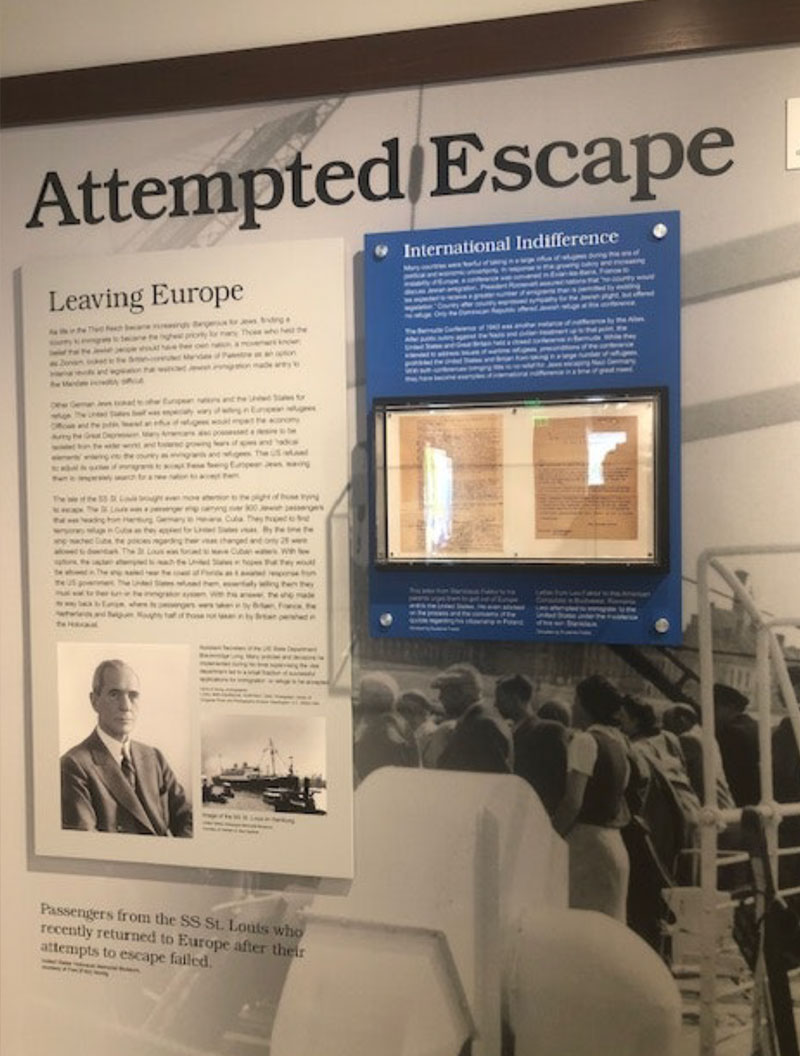
In July 1938, President Roosevelt called for an international conference in Evian, France to discuss the predicament of the Jewish people in Germany. Thirty-two countries, including America, sent representatives to the conference, yet while all expressed concern, only the Dominican Republic offered help. The State Department actively blocked Jewish immigration and President Roosevelt refused to give entry to 907 refugees abroad the SS St. Louis in the Spring of 1939, forcing the ship to return to Europe. Some passengers were able to find safe havens, but most were absorbed into areas the German military would soon occupy. As a consequence, just over half of the 532 refugees who remained would eventually die in the Holocaust.
Stop 7 - Invasion of the East

Within a year of Kristallnacht, “peace for our time” was no longer viable. On September 1st, 1939, German forces invaded Poland and began WWII. According to the Nazi belief in social Darwinism, the strong deserved to overpower the weak. The Nazis believed the Poles were a subhuman race and did not deserve claim to their land when it was so needed by Germany for Lebensraum, or living space. To achieve this, Hitler negotiated a Non-Aggression Treaty with Josef Stalin and agreed that Germany and the Soviet Union would invade Poland from opposite sides, thus splitting the country in two. Within 3 weeks, Poland had surrendered her land.
Immediately, those in leadership positions in Poland seen as a threat to Germany’s occupation were eliminated, including political and religious leaders, Polish soldiers, law enforcement personnel and even teachers. Poland also had the highest pre-war population of Jews in Europe, approximately 3 million compared to Germany’s 600,000. Ghettos were quickly established throughout German-occupied Poland; some were enclosed and consisted of numerous city blocks, others were open with just a road or two in a small town. Jews and Gypsies were the majority of people moved to these ghettos, later making it easier to transport prisoners in large numbers to concentration.
Stop 8 - Invasion of the West
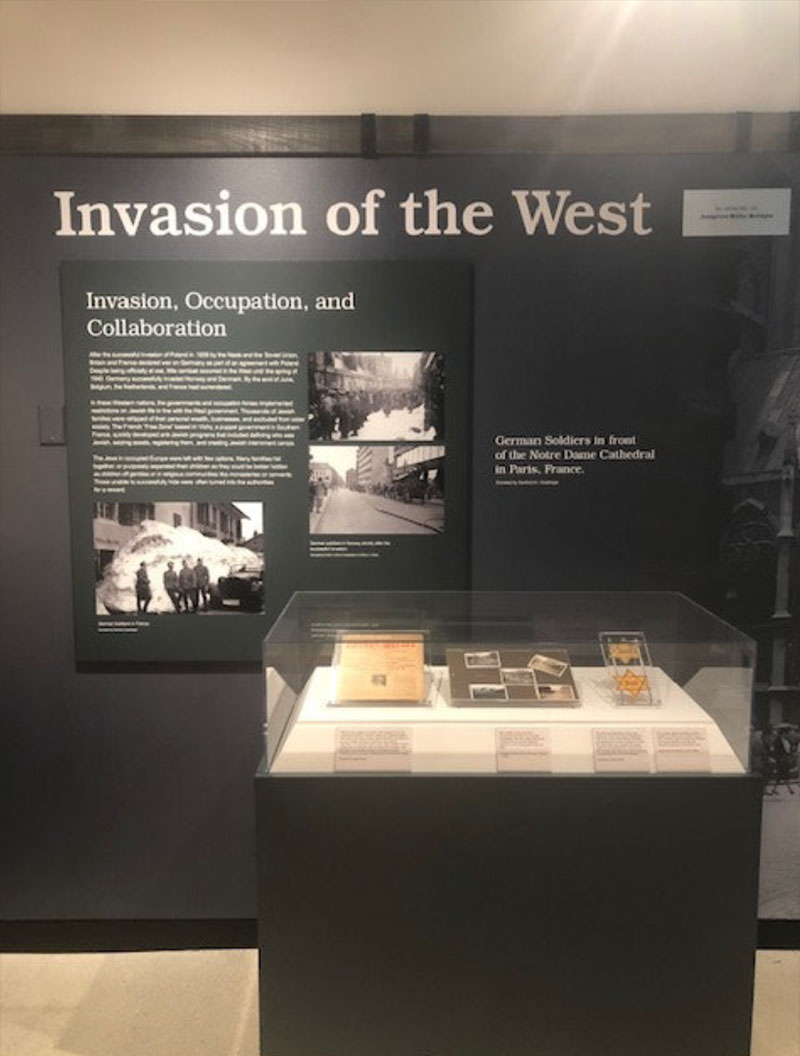
Once Hitler had control of western Poland, he turned his sights to Western Europe, invading France, Belgium and Holland on May 10th, 1940. The Blitzkrieg, or lighting war, that Germany unleashed was designed to be a quick and powerful mobilization against the West. It prevented any military force from acquiring enough time to organize and prepare a strong defense to halt the German army’s advance. As a result, Belgium and Holland surrendered to Germany in less than a week; France held out until late June before finally signing an armistice, dividing the country into a German-occupied zone and a free zone under the Vichy government. Over the course of the next few years, the Nazis implemented their anti-Jewish laws in the occupied Western countries, with most of the Jewish population eventually being sent “out east” to concentration camps and killing centers.
Stop 9 - Soviet Invasion & Mobile Death Squads
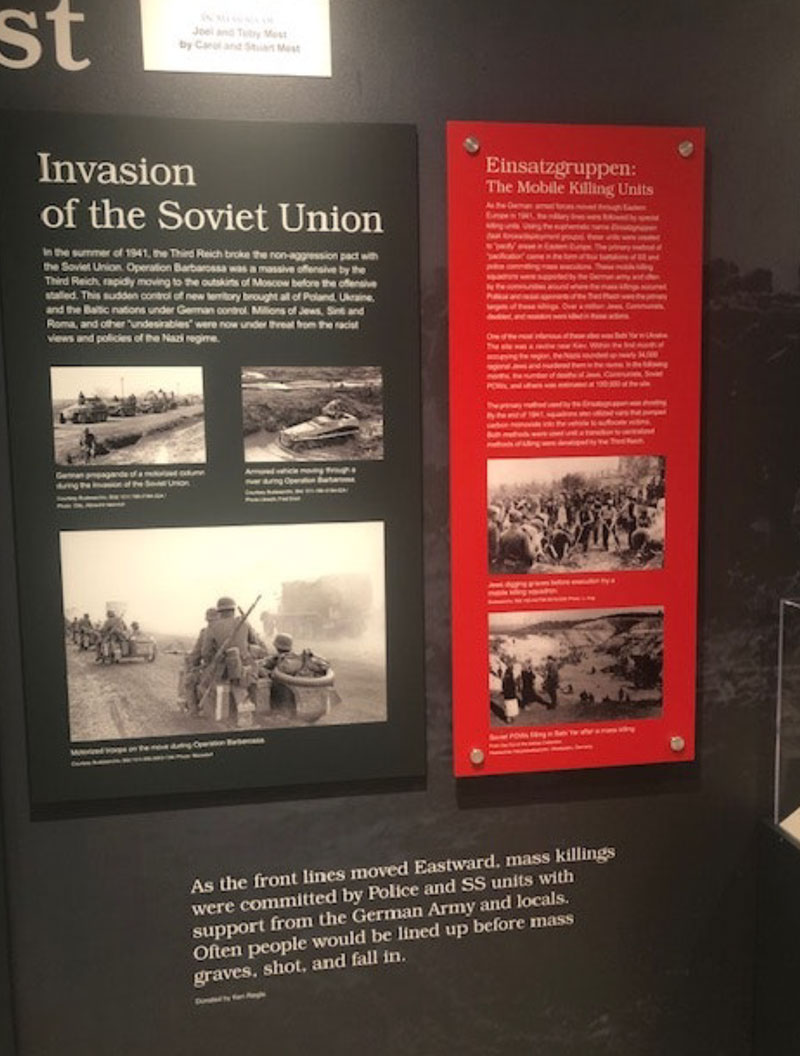
Despite signing a non-aggression pact with the Soviet Union, Hitler eventually started formulating plans for a military invasion beyond Poland. In June 1941, Hitler launched Operation Barbarossa and sent his army eastward into Soviet territory. As the Nazis invaded, groups of death squads known as Einsatzgruppen followed close behind to eliminate any undesirables or known political opponents in the local communities. The Einsatzgruppen murdered over 1.5 million men, women, and children, most of whom were shot to death after being taken to ravines, forest clearings, or other remote locations. Babi Yar in the Ukraine became the most notorious site of these killings, with an estimated 33,000 people murdered in just 48 hours.
Stop 10 - The Wannsee Conference

Death squads deployed to the East utilized modified vehicles referred to as “mobile killing vans” that ran gas tubes into sealed containers located at the back of the vehicle. Jews and other undesirables that were captured were placed into these vans and suffocated. This process, along with the knowledge gained from the T4 Euthanasia Centers that killed over 250,000 mentally or physically disabled people, led the Nazis to formulate the Final Solution, a plan to eliminate large numbers of Jews in the gas chambers of five Killing Centers in Poland. Select leaders were made aware of this plan during the Wannsee Conference in January of 1942. For the next 3 years, the pace of extermination increased dramatically. Until that time, only about 20% of those who would eventually be killed by the Nazis had died. In the final three years, with the industrialization of death, the remaining 80% were killed. Of the approximately 9 million Jews living in Europe at the start of WWII, less than 1/3 would remain at its conclusion. At least 5 million non-Jews also succumbed to the devastation as part of the Holocaust.
Once the decision to create Killing Centers and an efficient killing method were finalized, the plan to transport prisoners began. Until mid-1944, people received letters, or some other type of announcement, alerting them to the fact that they would be transported East and put to work. The notice stated what they should pack, how to label their suitcase, and when to report to the train station. Using already established railways throughout Europe, it was easy for the Nazis to deport people to camps across the occupied territories. People were generally loaded into boxcars or cattle cars, although some rode in passenger cars. The journeys could last anywhere from several hours to several days, depending on the final destination. No food or drink was given during the journey, and usually the windows were locked shut. For many, the process of deportation was a death sentence.
Stop 11 - Slave Labor
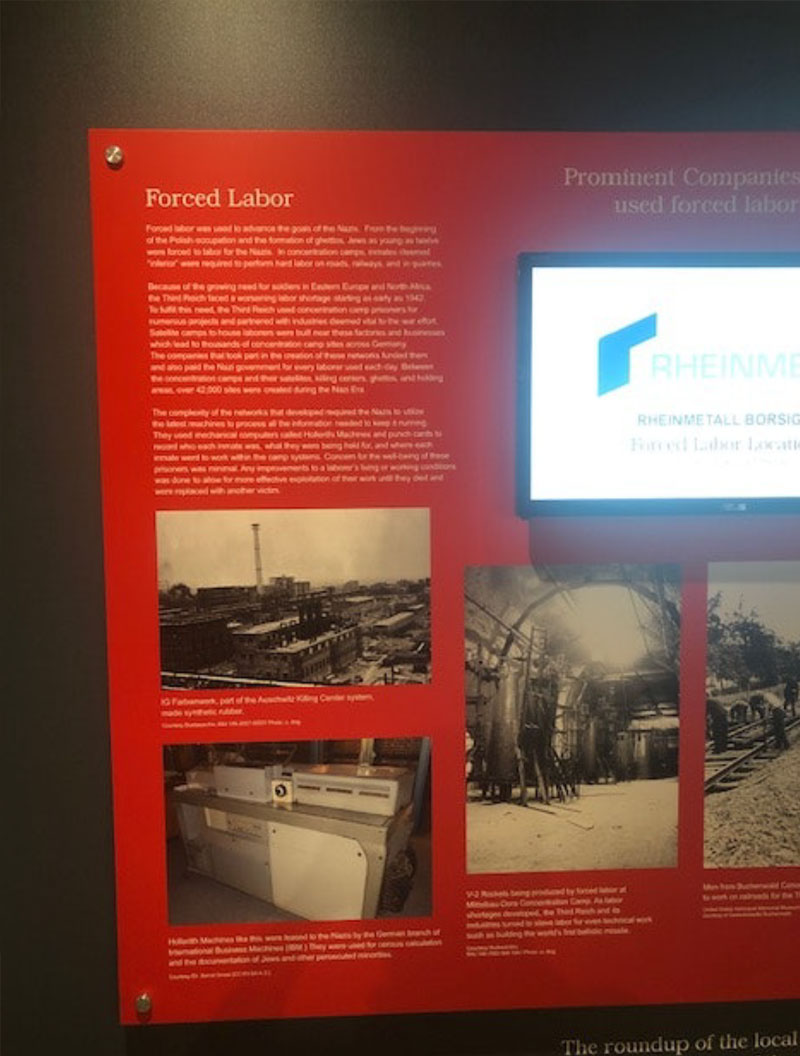
The Nazis created an intricate system of concentration camps throughout Europe, including Transit Camps, Prisoner of War Camps, Killing Centers, and Slave Labor Camps. Conditions were horrendous and people died from disease, starvation, being overworked or murdered by Nazi guards when they were no longer useful. Generally, rations in the camps were less than 1,000 calories per day per person. For the Nazis, unless a prisoner had a special skill, there was no need to keep them alive for a great length of time. Slave labor was so plentiful that Germany became heavily reliant on it. That reliance and access to a large pool of slave laborers meant that conditions could be inhumane. Many manufacturing companies, both German and those doing business with Germany, collaborated with the Nazi Regime and used the slave labor for their own economic benefits, compensating the government rather than the people doing the work.
Stop 12 - Killing Centers
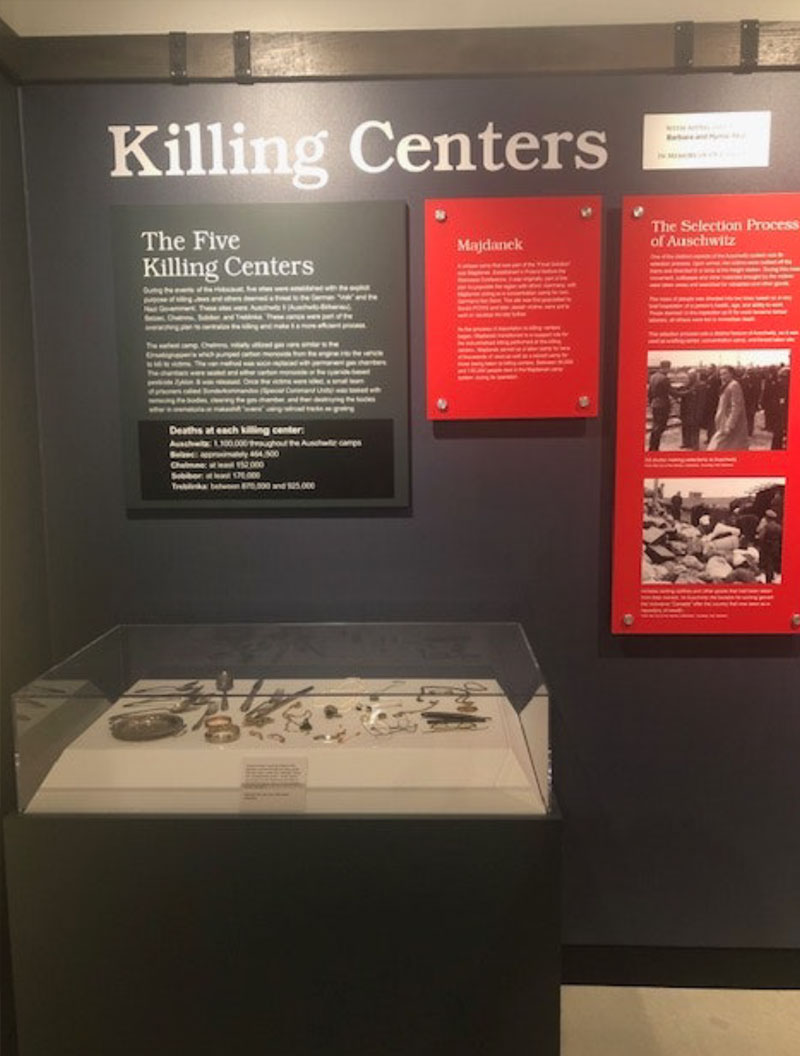
The main Killing Centers were located throughout Poland and consisted of Auschwitz, Belzec, Chelmno, Sobibor and Treblinka. Upon arrival, prisoners exited the trains and were divided into men and women, with children under 16 usually going with the women. The Selection process took place with guards making split second decisions on a prisoners’ usefulness. Based on that decision, the prisoners were taken to be registered and prepared for work or sent immediately to the gas chambers. Depending on the camp, the Nazis used Zyklon B pellets or carbon monoxide from engines as their agent of death. Large groups, stripped of their clothes, were forced into gas chambers disguised as a shower room in order to fool them. A small group of prisoners, called the Sonderkommando, was responsible for removing the bodies from the gas chambers and taking them to the crematoria to be burned.
Several of these camps also saw the Nazis carrying out medical experiments to further their research on the Master Race or to create strategies to assist their soldiers. In Auschwitz, Dr. Josef Mengele was in charge of such tests and attempted to further his understanding of eugenics by experimenting on twins and dwarves that were brought to the camp. While these individuals were spared from the gas chambers, they were used by Nazi doctors as guinea pigs and typically died from a horrific variety of tests or surgeries.
Stop 13 - Resistance

Contrary to popular belief, current research shows us the presence of resistance, by Jews and non-Jews, that began at the inception of Nazi rule. Resistance ranged from the non-violent White Rose in Germany and Oneg Shabbat in the Warsaw Ghetto, to assassination attempts on Hitler himself. Jews who were confined to ghettos or concentration camps often documented daily records of Nazi atrocities. Some records were smuggled out for the world to see. The largest Jewish-led resistance occurred in 1943, when Jews in the Warsaw Ghetto staged a full-scale uprising, which lasted for 29 days.
Stop 14 - Rescue
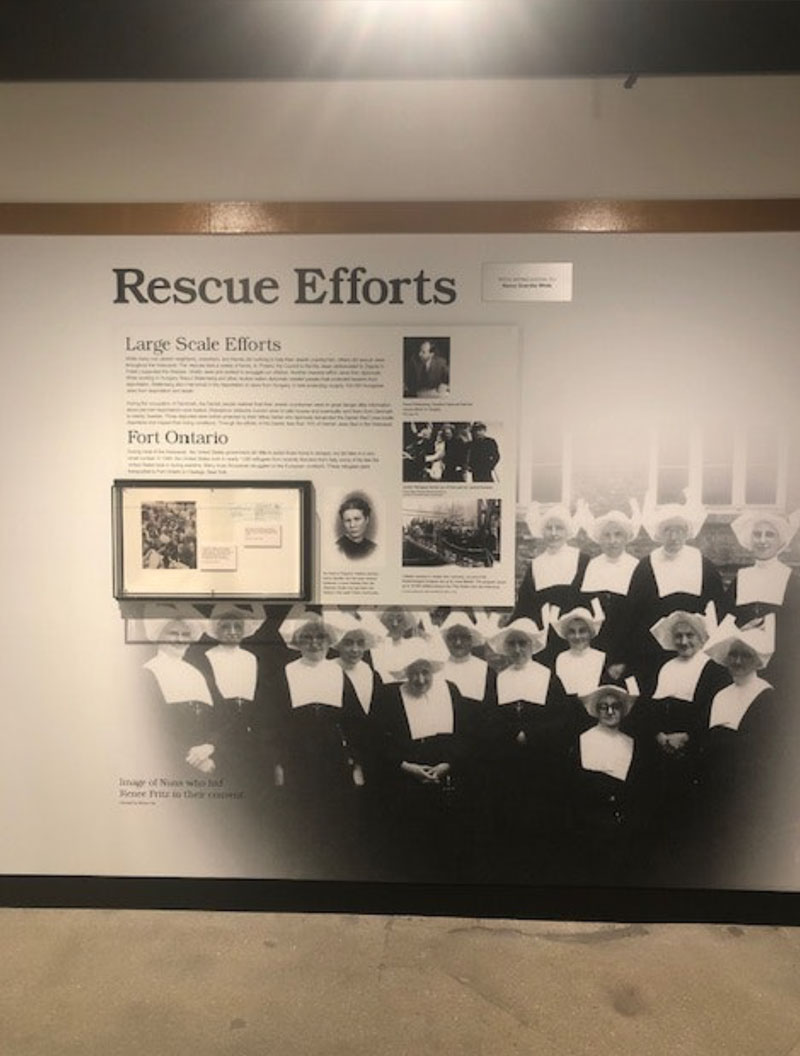
Swedish diplomat Raoul Wallenberg and fellow Hungarian diplomats protected roughly 100,000 Hungarian Jews from being deported. They provided valid passports or even directly intervened in the deportation process of already captured Jews.
Stop 15 - Liberation

As 1945 began, the Russian Army approached Berlin from the east, liberating Killing Centers in Poland along the way. Auschwitz, the largest of all the Nazi camps, was liberated on January 27th, 1945 by the Red Army. The Allies, including the Americans, Canadians, and British, approached from the west, liberating camps throughout Germany and Austria between April and May. On April 30th, Hitler, knowing the approaching armies would soon capture and hold him accountable for his actions, decided to commit suicide in his underground bunker in Berlin with his wife, Eva Braun. His death was announced the next day by Admiral Dönitz, who then negotiated the surrender of the German Army to the Allies, becoming official on May 8th, 1945.
During these last few months of the war, the Allies had discovered the depth of Nazi cruelty as they liberated concentration camps abandoned by the Nazis. In all the camps, the dead outnumbered the living, with most of those alive often weighing less than 80 pounds. Soldiers were horrified by what they found, prompting many to visit surrounding villages to demand acknowledgement and cooperation of local citizens. They were required to assist the living and bury the dead in mass graves. Most civilians were aware of the mass killings that had been occurring for years near their homes yet offered little opposition. This was also likely their first time seeing the camps with their own eyes, displaying the consequences of their silence.
Ohrdruf, a subcamp of Buchenwald, was the first camp to be liberated by American troops on April 4th. Generals Eisenhower, Patton, and Bradley visited the camp on April 12th. It was at this time that Eisenhower demanded everything be documented, ensuring that the legitimacy of these atrocities could not be denied later. He stated: I made the visit deliberately, in order to be in a position to give first-hand evidence of these things if ever, in the future, there develops a tendency to charge these allegations merely to “propaganda”. Many of the photographs seen here were taken by soldiers who now live in Southwest Florida. They graciously donated these items to our Museum so they could testify to the truth of what the Nazis did.
Stop 16 - Justice

At the conclusion of the fighting, the Allies formed the International Military Tribunal to hold Nazi Germany accountable for its crimes. France, Great Britain, the Soviet Union, and the United States provided lawyers and judges for the trial, at which 22 German military and civilian leaders were charged with conspiracy, crimes against peace, crimes against humanity, and war crimes. Following this initial trial, 12 others were held in Nuremberg and collectively, these 13 events are called the Nuremberg Trials. For the first time in history a sitting government, industry leaders and military leaders were held accountable for crimes against humanity. Although this was an imperfect system, it set the stage for what would become the International Criminal Court, allowing for the prosecution of genocide as an international crime with no statute of limitations. However, for many people the war did not end with the surrender of the German military or the criminal trials of the Nazis and their collaborators. For those displaced from their homes and separated from their families, recovery often took years.
Stop 17 - Displaced Persons

WWII had decimated the civilian landscape of Europe for nearly 6 years, resulting in millions of people being uprooted from their homes by the war’s end. Families returning home found their house had either been completely destroyed or was occupied by another family, leaving the original owners with nowhere to live. These refugees became known as Displaced Persons and were primarily comprised of either Holocaust and slave labor survivors or civilians that actively fled from battles. Camps were created for Displaced Persons as temporary housing, however the initial condition of these living spaces often mirrored Nazi concentration camps. Additionally, Jews typically lived in areas with non-Jews, some of whom held pro-Nazi beliefs and antisemitic views. A report made by U.S. Commissioner of Immigration & Naturalization Earl G. Harrison sought to improve conditions in the camps. Fearing European anti-Semitism, and the possibility of another Holocaust, the Bericha Movement was created. It helped thousands of Jews illegally immigrate to the British Mandate of Palestine. Unable to prevent Jews from entering the area, Britain granted the region to the Jewish community and the state of Israel was established.
Stop 18 - Surviving and Thriving: The Straus-Mandelbaum Story
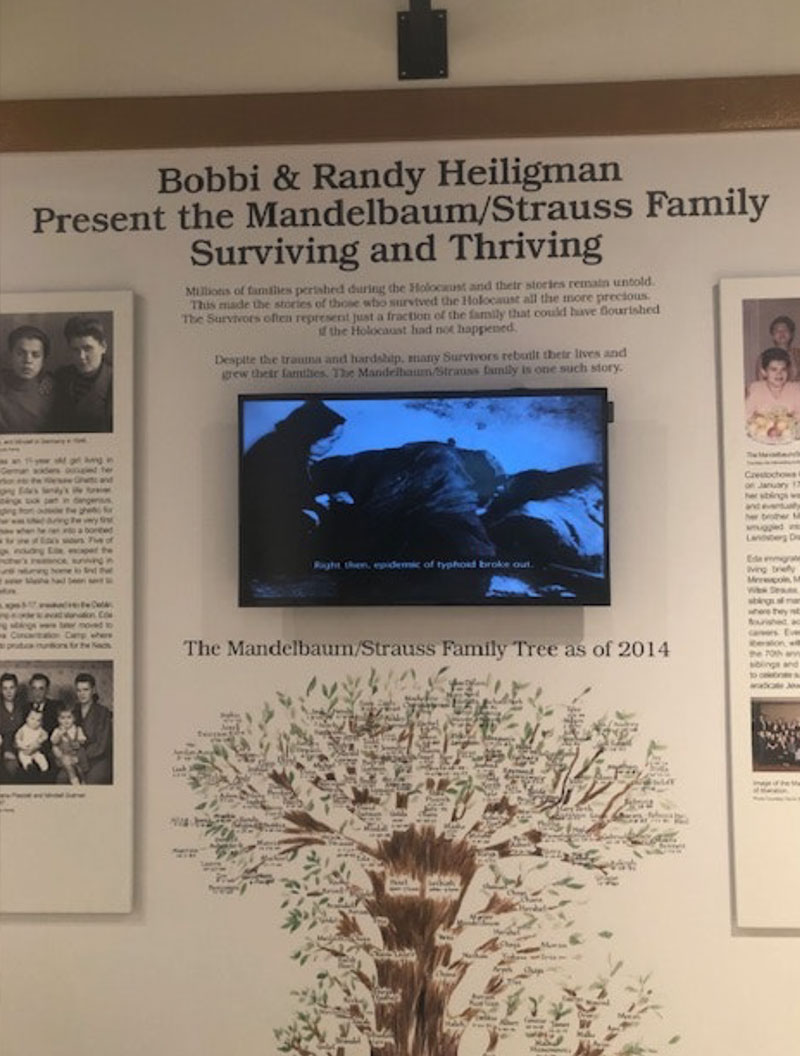
Tragedies that befell the Jewish community before, during and after WWII left a deep and glaring scar on the families affected. However, all those attacks failed to destroy their spirit. Regardless of the countless number of family lines cut short, many who survived have been able to rebuild their lives and even regrow their families. Eleven-year-old Eda Strauss, a Holocaust survivor saw her hometown of Warsaw occupied and changed into a ghetto. During her time in the ghetto Eda witnessed German soldiers shooting civilians at random on multiple occasions, even killing one of her friends while they were walking with one another. Eda’s father died in one of the first airplane bombings that hit the city and two of her seven siblings also perished in the ghetto. Despite these tragedies Eda was able to escape with her family and went on to rebuild her family tree.
Stop 19 - Genocide After the Holocaust
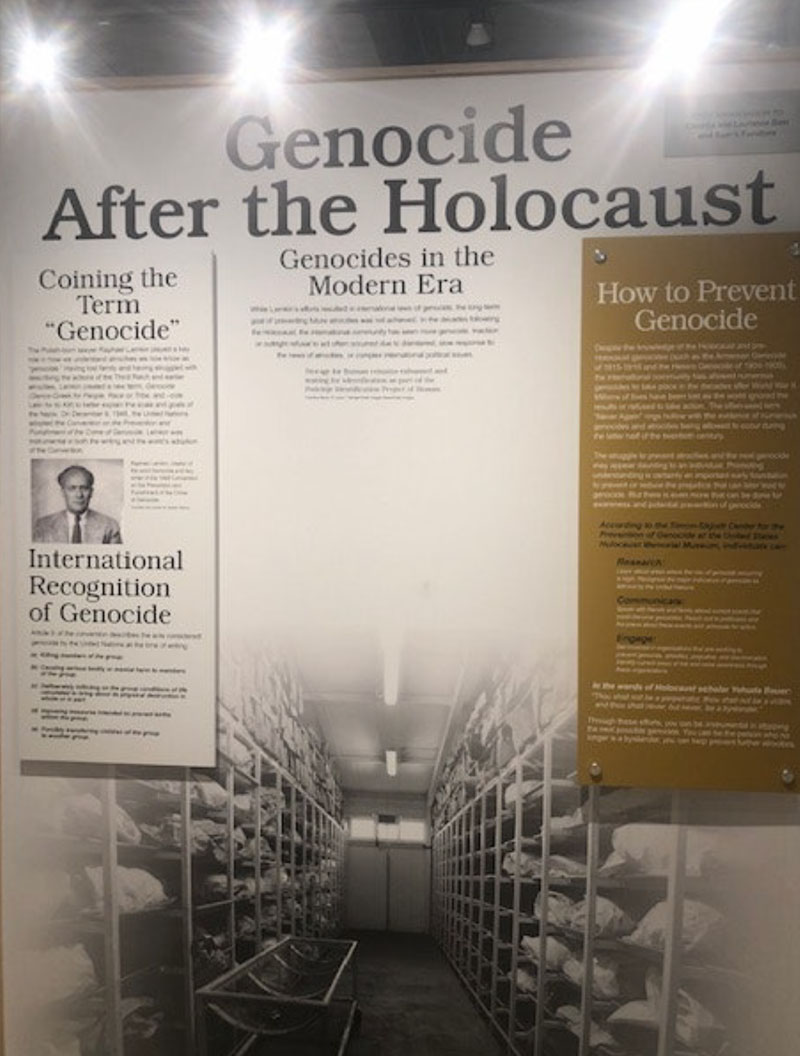
The term ‘genocide’ was created and defined by Raphael Lemkin, a Polish-born lawyer who lost his family to the Nazis. Lemkin helped write and establish the Convention on the Prevention and Punishment of the Crime of Genocide in 1948 for the United Nations. Article II of that document lists five acts that constitute genocide, all of which the Nazis committed. Despite universal knowledge of the Holocaust and procedures established by the United Nations, genocides continue. Inaction falls on nations as well as individuals who often feel they are powerless. Anne Frank did not survive and was unable to “go out into the world and work for mankind”. We can.
Thank you for taking our audio tour.
